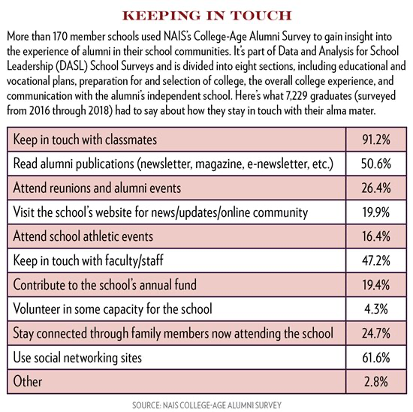It’s been an unprecedented, challenging spring for institutional advancement offices and school communications. From spring’s pandemic “shut-down” semester and virtual admission events to the nation’s unrest in the wake of George Floyd’s death, schools have wrestled with difficult (and, yes, necessary) issues of public health, human rights and an ever-shifting landscape in which we all function.
Then there is the issue of budget. The pandemic’s economic toll means that most schools must make hard decisions about what to keep and what to cut in the operating budget. For many, the alumni magazine may seem like easy pickings.
Now More Than Ever, Constituents Need the Alumni Magazine
I believe institutions of all sizes and types need to think long and hard about who their constituents are and how best to reach them. There is no question that we are all dependent today on forms of communication that did not even exist not so long ago, but I think this presents an opportunity for us to augment traditional print communications, not replace them.
Done well, an alumni magazine can amplify web content and drive traffic to a website while still also serving a vital role in reaching people who do not click-through from our emails or regularly visit our sites. I believe this is particularly true for our more mature populations, but I would argue that this can also hold true for younger generations as well.
The data support this. In a recent NAIS College-Age Alumni Survey, 50.6% of 7,729 recent independent school graduates (2016 through 2018) used the school magazine and newsletter to keep in touch with their alma mater vs. the school website (19.9%).
The Power of Storytelling in Print
An alumni magazine is an important storytelling tool for schools, an opportunity to highlight people, programs and campaigns in ways that are different from email or social media efforts. It is also a tremendous branding tool, reinforcing and extending institutional identity and pride among alumni.
Despite the rapid and far-reaching impact of digital communications over the past quarter-century, large segments of our population rely upon the alumni magazine. In fact, so many of our constituents prefer the opportunity to receive a magazine, thumb through its pages, see its imagery and read its stories.
At Saint Francis High School, we see great responsiveness from alumni to our magazine. Despite (or maybe because of) the constant barrage of digital communication we all receive, the magazine is a piece that can have a shelf life well beyond any email newsletter.
Our most recent issue of Progress, our twice-annual alumni magazine, is a good example of strategic planning and adaptability in a print publication. When our school shut down in-person classes and activities in early March, we were well into magazine production. We had our feature story written and all other copy – campus news, class notes, etc. – was in the editing stage.
Our team recognized that publishing an issue that did not address the pandemic would be tone deaf. Our students and staff were adapting to and embracing remote learning and our school community, including parents and alumni, were helping those in need in the Bay Area in wonderful ways that underscored our school’s Holy Cross mission (Saint Francis is a coed, Catholic school for 9-12th grades).
The easier strategy would’ve been to scrap the feature article, print the basic news and class notes, and explain in the letter from our President Jason Curtis why there was not a feature story. Instead, we created a series of features about our pandemic response, academically, spiritually and philanthropically, including interviews with alumni and parents on the front lines of fighting the pandemic and caring for others. We left the campus news and class notes as is to celebrate all that had come before the coronavirus pandemic.
This decision did push our publication timeline a bit. As I write this post, our issue is hitting mailboxes. I hope that our alumni will see the ways the Saint Francis community rallied in a time of crisis, both for the school and for the greater community we serve, and feel proud and inspired. This message and the stories that support it could only have been shared in the pages of the magazine for such a widespread audience.
Budgetary Constraints and Print vs. Digital
At Saint Francis, we mail our semi-annual issues of Progress (our alumni magazine) and an annual report to all constituents, alumni, parents and friends. We are certainly constrained by rising postage and printing costs, the perceived ROI of a major print piece and the timeliness of the content given the time it takes to produce and distribute before it reaches someone’s mailbox. That said, I think building continuity in our timetable for production year over year is important. While the COVID-19 pandemic forced a delay in our Spring 2020 issue as we pivoted our content, maintaining a firm publication schedule each spring and fall will be our goal going forward.
At some institutions I’ve been with the magazine would ebb and flow depending on other projects and when and where it could “fit in.” I believe this is a poor choice. I think any periodical should be produced on a regular schedule, one that people come to expect and even look forward to, and one that is a vital part of the overall communications plan alongside web, email and social media, not an afterthought. In my experience, this is a cost-saving measure, because it is budgeted for ahead of time and is not a fire drill that occurs outside the normal workflow each year. This provides ample content that can also be re-purposed and expanded upon digitally.
I think we’ll continue to see an evolution toward less print and more online content, but we also may reach a point of diminished returns by over-reliance on digital as well. As with so many things in life, balance is key. I think institutions that can effectively leverage print and electronic content and drive traffic between the two stand the best chance for continuing meaningful, long-standing relationships while continuing to build new ones.
Like newspapers, magazines must establish an effective web presence and offer deeper and more interactive engagement opportunities online and via social media that build upon what appears in print. I’m a firm believer, though, that there is still a very important role for magazines in engaging audiences now and in the future.
Keep the Goal in Mind
These are tough times for schools, and the fiscal decisions we need to make are challenging and have long-term consequences. As you look at line items, though, remember the bottom line of what we seek to foster in the work we do in institutional advancement and through our alumni magazines.
We share our stories, connect alumni, engage parents and raise funds to provide for our students and educators. Our pages help to continue the traditions that define our schools. And, now more than ever, we help people find a renewed sense of hope and optimism for brighter days ahead by reminding them of their enduring connection to an institution that helped to shape who they are.
Read the spring 2020 issue of “Progress” – Saint Francis’ Alumni Magazine Spring 2020.
Editor’s note: Saint Francis High School recently completed a three-publication collaboration with Kalix Marketing to write, edit and design two issues of Progress, the Saint Francis High School alumni magazine, and its 2019-20 donor report.
 About Paul Lanning, Ed.D., CFRE
About Paul Lanning, Ed.D., CFRE
Executive Director of Institutional Advancement, Saint Francis High School
With over two decades of institutional advancement leadership for secondary schools, colleges, universities and nonprofits in California, Dr. Lanning has extensive experience leading all aspects of fundraising, marketing, communications, governmental relations, event planning and management, and staff and board development. He joined Saint Francis High School in July 2019 and is leading the school’s planned $100 million comprehensive campaign and a multi-faceted advancement staff.
Prior, Dr. Lanning was Vice President for University Advancement and CEO of the Tower Foundation at San José State University for four years, where he led all advancement functions. Of note, he co-founded SJSU’s Institute for the Study of Sport, Society and Social Change with Dr. Harry Edwards to extend and enhance the university’s historic commitment to social justice. He co-founded and was a managing partner of Sacramento’s Ascend Partners Group, LLC, a full-service, nonprofit consulting group. In addition to other leadership roles in nonprofits, Dr. Lanning served as president and CEO of the Foundation for California Community Colleges, the nation’s largest system of higher education. He received his B.A. in Political Science from the University of California, San Diego, his M.S. in Sport Management from the University of Massachusetts, Amherst, and his Ed.D. from University of the Pacific.



